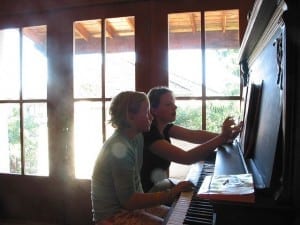 Teachers, when your student asks a question do you immediately give them the answer? Music teacher Peggy J. shares her teaching tips for guiding students to solutions instead of handing them an easy answer. Read on and discover the importance of teaching your students problem-solving skills…
Teachers, when your student asks a question do you immediately give them the answer? Music teacher Peggy J. shares her teaching tips for guiding students to solutions instead of handing them an easy answer. Read on and discover the importance of teaching your students problem-solving skills…
Musicians are unique performing artists in that they must do most all of their daily decision-making and practicing alone. Dancers prepare for a day of rehearsal by warming up in a teacher-led class and then rehearsing daily with an artistic director. Actors, too, rehearse primarily in the constant presence of a director.
A musician’s daily warm-up and practice time is done in complete isolation. It is only in a weekly lesson that they share their week’s progress with the teacher, receive new information, and work together to solve existing problems. The teacher’s job is not only to build a logical, organized understanding of music theory, but to provide the growing musician with a tool belt of resources to use as he develops the discipline needed to become an independent practitioner.
Ultimately, even with a teacher to help guide or troubleshoot, a successful musician will spend hours and hours of his life practicing and making decisions about how a to phrase a line or finger an ornament based on the arsenal of “tools” he has accumulated during consistently clear and effective lessons. To promote proactivity, an interactive exchange with the teacher asking the student questions to prompt the problem-solving process is an important element. In this way, the student discovers his own solutions to issues regarding technique, style, and theory based on information the teacher has previously reinforced. Having solved one’s own problem, the student is much more likely to understand and remember what has been learned.
Of course, the teacher is always carefully guiding and molding the student’s thinking. For example, when my ten-year-old piano student Nicholas was having difficulty “nailing” the bottom “C” in a wide spread cadential chord, I first asked him if he had any ideas on how to remedy this based on things we’d worked on in the past. Being unsure, I reminded him of our exercises regarding the feel of certain intervals in his left hand. He remembered that the octave was easy to feel, and by guiding off of his thumb, he could easily find the same note an octave below. I asked how he could apply this technique to make it easier to “nail that C.” He discovered that by guiding off of his thumb, a smaller jump with a stronger finger, his fifth finger found the lower “C” with confidence and accuracy.
Since he actually discovered the solution, he was much more likely to apply it to other similar situations. In truth, a musician never stops growing, learning, and finding other resources to add tools to his tool belt. He applies all he’s acquired from numerous sources, including his well-practiced self-discipline in honing his craft. It is that invaluable habit of self-discipline developed through effective musical training that will positively affect a student’s entire educational career.
Peggy J. teaches music theory, singing, and piano lessons in Milwaukee, WI. She has been teaching for 35 years and joined the TakeLessons team in July 2013. Peggy specializes in providing a strong emphasis on theory in genres ranging from classical music to contemporary. Learn more about Peggy or search for a teacher near you!
You might also like…
–Teaching Tips: The Power of Positive Language
–The Lessons I’ve Learned from Teaching
–Teaching Tips: The Ultimate Recital Survival Guide
Photo by Tom Sparks
Megan L.